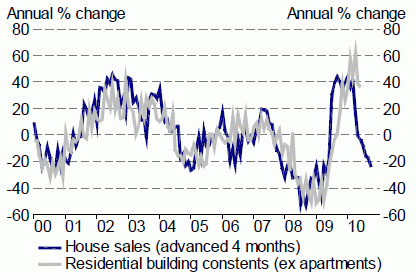
Treasury believes the economy remains on track to deliver the GDP growth forecast in the May 2010 budget, but that the makeup may be tilted more to export sector than the moribund domestic sector.
Treasury made the comments in its Monthly Economic Indicator series, which summarises the latest monthly economic data and compares it with its previous official forecasts.
"While data released in July shows some downside risks to domestic demand, indicators point to ongoing strength in the exporting sector," Treasury said.
"Strong export growth is consistent with a reorientation of growth from consumption towards production and the tradables sector," it said.
Treasury noted that a softening of the housing market would drag on residential investment in the second half of the year.With a degree of slack in the housing market, there is expected to be limited growth in house prices in coming months.
"A subdued housing market highlights a downside risk to domestic demand. While there may be a flourish in construction activity leading up to the October rise in the GST rate, the general tone of weak sales activity is likely to act as a drag on the pace of the recovery in residential investment."
Here is Treasury's executive summary below:
Headline inflation is set to increase in coming quarters as one-off government charges, such as the 1 October GST rate rise, flow through to final prices.
Firms’ pricing intentions have lifted sharply in recent months, reflecting these government-related charges, but firms are likely to face difficulties passing on price rises in an environment of weak demand. Business surveys revealed a pull-back in firms’ outlook for their own activity, but are still consistent with ongoing, moderate growth.
In the face of high debt levels and weak income growth, households continue to exercise spending restraint. Consumers are holding back on discretionary spending, suggesting that private consumption will fall short of our Budget forecasts in the June quarter.
Moreover, a softening housing market in the first half of 2010 will act as a drag on the pace of the recovery in residential investment in the second half of the year. High international commodity prices and demand for New Zealand’s main exports are supportive of ongoing growth in the export sector.
A rise in the value of merchandise exports in the June quarter contributed to the second consecutive quarterly trade surplus, driven by higher volumes and prices for most of New Zealand’s main export products.
World data released in July show that the pace of the world economic recovery may be easing, indicating a potential risk to NZ’s export-led recovery. However, with NZ’s trade being oriented towards Asia and Australia, strong economic growth recorded in these countries will help to boost exports over 2010.
While data released in July shows some downside risks to domestic demand, indicators point to ongoing strength in the exporting sector. Strong export growth is consistent with a reorientation of growth from consumption towards production and the tradables sector.
We maintain our assessment that GDP growth will remain broadly in line with our Budget forecast.

We welcome your comments below. If you are not already registered, please register to comment.
Remember we welcome robust, respectful and insightful debate. We don't welcome abusive or defamatory comments and will de-register those repeatedly making such comments. Our current comment policy is here.